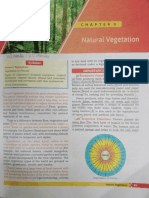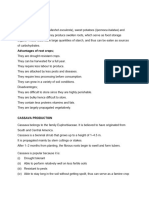100%(1)100% found this document useful (1 vote)
132 viewsBio Engineering
Bio-engineering uses live plants or plant parts to control soil erosion and stabilize slopes through engineering functions. There are different categories of bio-engineering including simple planting, structures using vegetation, and composite systems. Common bio-engineering techniques in Nepal include grass seeding for surface protection, tree and shrub planting to anchor surface layers, and bamboo planting for slope support and debris trapping.
Uploaded by
Shuvanjan DahalCopyright
© © All Rights Reserved
Available Formats
Download as DOCX, PDF, TXT or read online on Scribd
100%(1)100% found this document useful (1 vote)
132 viewsBio Engineering
Bio-engineering uses live plants or plant parts to control soil erosion and stabilize slopes through engineering functions. There are different categories of bio-engineering including simple planting, structures using vegetation, and composite systems. Common bio-engineering techniques in Nepal include grass seeding for surface protection, tree and shrub planting to anchor surface layers, and bamboo planting for slope support and debris trapping.
Uploaded by
Shuvanjan DahalCopyright
© © All Rights Reserved
Available Formats
Download as DOCX, PDF, TXT or read online on Scribd
You are on page 1/ 1
BIO-ENGINEERING: water
Other Inert Structures Numerous; these often need to be
Bio-engineering is the use of live plants or plant parts to control soil with Vegetation designed specifically for individual
erosion and the mass movement of land, in order to fulfill engineering added sites
functions.
Basic Principles and Techniques: Some Plants used in Bio-Engineering with their Effective Rooting
There are different methods of using vegetation to protect and stabilize Depth
slopes. The main categories are: Plant Type Examples Effective Rooting
a. Simple Planting (e.g. grass seeding; planting trees, shrubs and Depth (m)
bamboos) Small Cynodon dactylon (दु बो) 0.1
Grasses Pennisetum clandestinum
b. Structures using Vegetation (e.g. lines of grasses or of shrub
cutting, in the form of brush layering) (किकियु )
c. Composite Systems (e.g. planted jute netting or vegetated stone Large Saccharum spontaneum (ि ाँ ख) 1.0
pitching) Grasses Thysanolaena maxima
(अकिसो)
Common Bio-Engineering Techniques appropriate to Nepal and their
Contribution Cymbopogon microtheca (खर)
Large Dendrocalamus hamiltoni 1.5
Class Technique Contribution to the Slope Bamboo (चोय ब ाँ स)
Simple Grass Seeding Surface protection against erosion Bambusa nutans (मल ब ाँ स)
Planting Tree and Shrub Anchoring of the surface layers;
Seeding reinforcement
Shrubs Woodfordia fruticose (धन्येरो) 1.5
Grass Planting Surface protection against erosion Butea minor (भुजेत्रो)
Tree and Shrub Anchoring of the surface layers Trees Melia azedarach (बि इनो) 2.0
Planting Acacia catechu (खयर)
Big Bamboo Planting Support to the slope; trapping of
Alnus nepalensis (उकिस)
debris
Turfing with Grass Surface protection against erosion
Structures Lines of Grasses Protection against erosion; trapping
using of debris; channeling of runoff
Vegetation Lines of Shrub Protection against erosion; trapping
Cuttings (Brush of debris; channeling of runoff
Layering & Palisades)
Bundles of Cuttings Channeling of runoff; drainage
(Fascines)
Composite Planted Jute Netting Protection against erosion on very
steep slopes
Vegetated Rip-Rap Protection against erosion in areas
where there is a lot of running
You might also like
- Theory of Vibrations: Assignment-1 (Solutions)50% (2)Theory of Vibrations: Assignment-1 (Solutions)13 pages
- Mix Design of Concrete and Properties of Green Concrete100% (9)Mix Design of Concrete and Properties of Green Concrete32 pages
- Comments Leading To Key Messages Development UpdatedNo ratings yetComments Leading To Key Messages Development Updated32 pages
- 22. Introduction to Landslide Stabilization and Mitigation (Parte 2)No ratings yet22. Introduction to Landslide Stabilization and Mitigation (Parte 2)32 pages
- Assessment of Constructed Wetlands For Treatment of Domestic Wastewater in Small Communities: Konya City (Turkey) ExperiencesNo ratings yetAssessment of Constructed Wetlands For Treatment of Domestic Wastewater in Small Communities: Konya City (Turkey) Experiences6 pages
- Shelterbelts and Windbreaks: Principles For Installation: Tree Elements For Wind ProtectionNo ratings yetShelterbelts and Windbreaks: Principles For Installation: Tree Elements For Wind Protection2 pages
- Integrated Management of Living Mulches for Weed Control a ReviewNo ratings yetIntegrated Management of Living Mulches for Weed Control a Review13 pages
- Plant Nursery Management Manual - UpdatedNo ratings yetPlant Nursery Management Manual - Updated22 pages
- 21.11 Human Influences On Ecosystems Igcse Cie Biology Ext Theory QPNo ratings yet21.11 Human Influences On Ecosystems Igcse Cie Biology Ext Theory QP13 pages
- Large-scale Impacts of Selective Logging on CanopyNo ratings yetLarge-scale Impacts of Selective Logging on Canopy13 pages
- Handbook On Miyawaki Forest in West Bengal100% (1)Handbook On Miyawaki Forest in West Bengal20 pages
- Plants Used in Constructed Wetlands With Horizontal-Review100% (2)Plants Used in Constructed Wetlands With Horizontal-Review24 pages
- Ecological functions of bamboo forest in the PhilippinesNo ratings yetEcological functions of bamboo forest in the Philippines5 pages
- 2E-4 Bioretention Cells: Iowa Stormwater Management ManualNo ratings yet2E-4 Bioretention Cells: Iowa Stormwater Management Manual28 pages
- CoppiceForestsInEurope_1-4_Lazdina-etal_Glossary_Sept2018No ratings yetCoppiceForestsInEurope_1-4_Lazdina-etal_Glossary_Sept201812 pages
- Rejuvenation of Reserve Forest by Forest Interventions (Species and Different Plantations)No ratings yetRejuvenation of Reserve Forest by Forest Interventions (Species and Different Plantations)7 pages
- Pages From Volume 4 - Penang Durian Valley @ Relau-12 (1)No ratings yetPages From Volume 4 - Penang Durian Valley @ Relau-12 (1)28 pages
- Theory of Vibrations: Assignment-2 (Solutions)100% (3)Theory of Vibrations: Assignment-2 (Solutions)14 pages
- NBC Update - Final Report-Building Code July 15 09No ratings yetNBC Update - Final Report-Building Code July 15 09170 pages
- The Importance of Ethics in The Engineering Sector80% (5)The Importance of Ethics in The Engineering Sector3 pages
- Water Treatment (Water Supply Engineering)100% (11)Water Treatment (Water Supply Engineering)40 pages
- Quality of Water (Water Supply Engineering)100% (2)Quality of Water (Water Supply Engineering)11 pages
- Introdution To Concrete and Concrete Materials (Concrete Technology)100% (1)Introdution To Concrete and Concrete Materials (Concrete Technology)25 pages
- Quantity of Water (Water Supply Engineering)100% (8)Quantity of Water (Water Supply Engineering)7 pages
- Sources of Water (Water Supply Engineering)86% (7)Sources of Water (Water Supply Engineering)9 pages
- Maintenance and User'S Manual: Pensky Martens Flash Point TesterNo ratings yetMaintenance and User'S Manual: Pensky Martens Flash Point Tester54 pages
- Successive Approximation ADC - Wikipedia, The Free EncyclopediaNo ratings yetSuccessive Approximation ADC - Wikipedia, The Free Encyclopedia4 pages
- JNTUH M.Tech 2017-2018 (R17) Detailed Syllabus Tall BuildingsNo ratings yetJNTUH M.Tech 2017-2018 (R17) Detailed Syllabus Tall Buildings12 pages
- FINAL Exam Schedule For 1st Semester SY 2019-202075% (8)FINAL Exam Schedule For 1st Semester SY 2019-202054 pages
- Softening Point of Pitches (Cube-in-Water Method) : Standard Test Method ForNo ratings yetSoftening Point of Pitches (Cube-in-Water Method) : Standard Test Method For4 pages
- Typical Velocities Piping Design Chemical Engineering Robert KernNo ratings yetTypical Velocities Piping Design Chemical Engineering Robert Kern1 page
- Rajan Object Or75678iented Numerical Methods Via C100% (1)Rajan Object Or75678iented Numerical Methods Via C589 pages
- 501/423 Cable Gland Type: Flameproof and Increased SafetyNo ratings yet501/423 Cable Gland Type: Flameproof and Increased Safety1 page
- Antennas Terman McGraw Hill Engineering 1953No ratings yetAntennas Terman McGraw Hill Engineering 1953566 pages
- Revision Notes For Exam 2011 Computer Science75% (4)Revision Notes For Exam 2011 Computer Science52 pages






















































































































